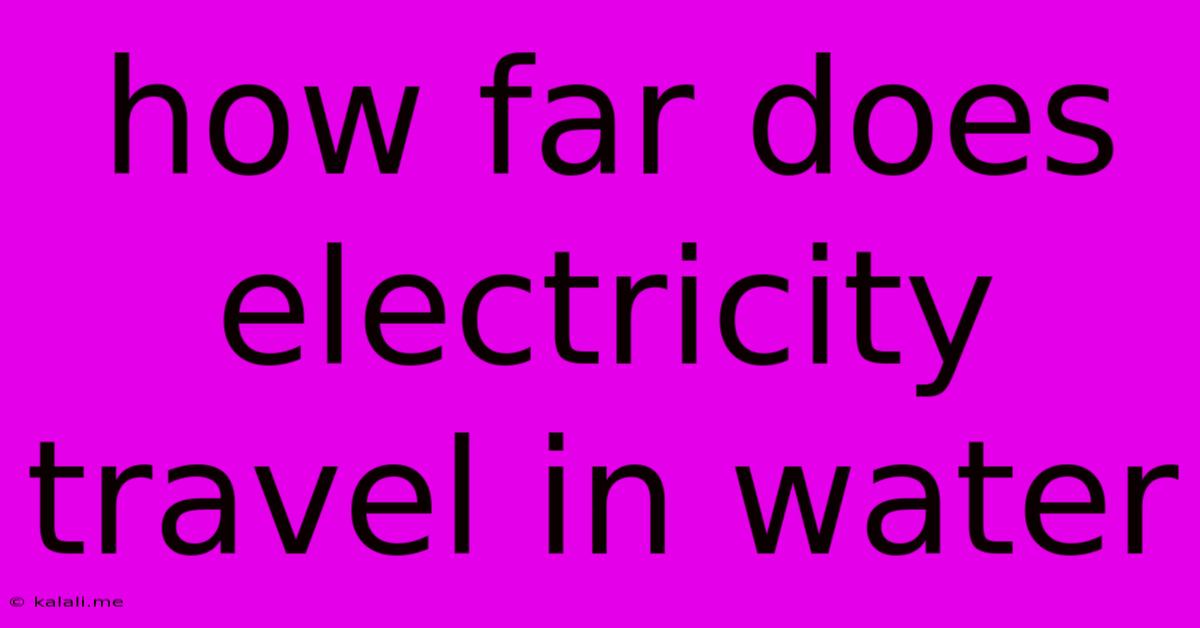How Far Does Electricity Travel In Water
Kalali
Jun 06, 2025 · 3 min read

Table of Contents
How Far Does Electricity Travel in Water? A Deep Dive into Electrical Conductivity in Water
Meta Description: Discover how far electricity travels in water, exploring factors affecting conductivity like water type, temperature, and dissolved minerals. Learn about the dangers and applications of electricity in aquatic environments.
Electricity's journey through water isn't a simple case of a fixed distance. Instead, it's a complex interaction influenced by several key factors. Understanding how these factors affect electrical conductivity is crucial, whether you're concerned about safety around water or exploring its applications in various fields.
Factors Affecting Electrical Conductivity in Water
Several factors determine how effectively electricity can travel through water:
-
Water Purity: Pure water (distilled water) is a poor conductor of electricity because it lacks dissolved ions. The more impurities, like salts, minerals, and other dissolved substances, the higher the conductivity. Seawater, for instance, is a much better conductor than freshwater due to its high salt content.
-
Temperature: Generally, higher temperatures increase conductivity. Increased thermal energy boosts the movement of ions, facilitating the flow of electric current.
-
Dissolved Minerals and Salts: These are the primary contributors to a water body's conductivity. Minerals like sodium chloride (table salt) readily dissociate into ions (Na+ and Cl-), significantly enhancing the water's ability to conduct electricity. The concentration of these dissolved solids directly impacts conductivity.
-
Water Type: As mentioned, freshwater, saltwater, and even rainwater vary significantly in conductivity due to differing dissolved ion concentrations. Rainwater, while purer than most other sources, still carries dissolved gases and minerals, making it a conductor (though a relatively poor one compared to seawater).
-
Presence of Other Substances: Other substances dissolved in the water, such as acids and bases, will also affect conductivity. These substances further contribute to the number of charge carriers (ions) available to conduct electricity.
How Far, Then? The Role of Resistance
Instead of focusing on a specific distance, it's more accurate to consider the resistance of the water to the electrical current. High resistance means electricity travels a shorter effective distance; low resistance means it can travel further. The factors listed above directly influence this resistance. A highly conductive saltwater environment will allow electricity to spread much further than a poorly conductive freshwater environment.
Dangers of Electricity in Water
The ability of water to conduct electricity poses significant dangers. Even seemingly small amounts of current can cause severe shocks, burns, and even death. Never handle electrical appliances near water, and always exercise extreme caution in aquatic environments where electricity might be present.
Applications of Electricity in Water
Despite the inherent risks, electricity finds crucial applications involving water:
- Electrolysis: This process uses electricity to separate water into hydrogen and oxygen.
- Water Treatment: Electricity plays a role in various water treatment processes, including disinfection and the removal of contaminants.
- Hydroelectric Power Generation: Harnessing the energy of flowing water to generate electricity is a widely used renewable energy source.
- Marine Technologies: Submarine communication and other underwater technologies rely on the principles of electrical conductivity in water.
Conclusion
The distance electricity travels in water isn't a fixed value. The conductivity of water, and thus the effective distance of electrical travel, depends on numerous factors, primarily the concentration of dissolved ions and the temperature. Understanding these factors is essential for both safety and the effective application of electricity in aquatic environments. Always prioritize safety when working with electricity near water.
Latest Posts
Latest Posts
-
Life Expectancy Of A Maple Tree
Jun 07, 2025
-
In The Supreme Triumph Of Gods Will
Jun 07, 2025
-
How Do You Cook Tamales Without A Steamer
Jun 07, 2025
-
Configure Error C Compiler Cc Is Not Found Ubuntu
Jun 07, 2025
-
How Do Door Side Windows Attach
Jun 07, 2025
Related Post
Thank you for visiting our website which covers about How Far Does Electricity Travel In Water . We hope the information provided has been useful to you. Feel free to contact us if you have any questions or need further assistance. See you next time and don't miss to bookmark.